I LOVE this design technique. I think some people call it the spoon swirl; I call it the plop swirl because when I’m plopping the soap into a mold, I can’t help but say “PLOP” every time! This is a great design technique for when your soap gets a little too thick to do other swirls.
 For more details on making goat milk soap, check out our eBook Goat Milk Soapmaking! It includes directions for full-milk soapmaking as well as the milk-in-oil method.
For more details on making goat milk soap, check out our eBook Goat Milk Soapmaking! It includes directions for full-milk soapmaking as well as the milk-in-oil method.
It is pumpkin season! This recipe features pumpkin puree and goat’s milk.
Pumpkin Goat Milk Plop Swirl Recipe
Coconut Oil – 10 oz.
Shea Butter – 4 oz.
Olive Oil – 12 oz.
Rice Bran Oil – 6 oz.
Lye – 4.5 oz.
Pumpkin Puree – 5 oz. (canned puree works great, DO NOT get pie filling)
Frozen Goat Milk – 4 oz.
Orange Mica – 1 teaspoon
Charcoal – 1/2 teaspoon
Green Oxide – 1 teaspoon
Orange Essential Oil – .5 oz.
Peru Balsam Essential Oil – .5 oz.
Ylang Ylang Essential Oil – .2 oz.
Patchouli Essential Oil – .5 oz.
Cassia Essential Oil – .2 oz.
(Or you can use a pumpkin fragrance oil! Just know that most pumpkin fragrance oils move quickly and contain vanilla, which will make your soap tinted brown.)
Mold – This soap fits in a 10″ Silicone Mold from Bramble Berry (affiliate link http://www.brambleberry.com/10-Silicone-Loaf-Mold–P5199.aspx?bb=5).
Safety Warning: This recipe is for soapmakers who have a basic knowledge of the soapmaking process and know the correct safety procedures to use when handling lye. If you are new to soapmaking, visit lovinsoap.com or soapqueen.com for more detailed beginner instructions. Be sure to wear safety goggles and gloves while soaping.
Step 1 – Weigh out the lye into a container. Set aside.
Step 2 – Weigh out the pumpkin and goat’s milk into another container together. I like to use frozen goat’s milk.
Step 3 – Sprinkle the lye onto the pumpkin/goat milk. Stir. The lye will melt the goat milk and liquify the pumpkin puree.
Step 4 – Weigh the coconut oil and shea butter into a container and melt.
Step 5 – Add the liquid oils to the melted oils. This helps to drop the temp. Add your fragrance and essential oil to the oils.
Step 6 – Wait for the oils and lye solution to drop to 90F. You can put the lye solution in the fridge or in an ice bath to drop the temp.
Step 7 – Once temps have dropped to 90F or below, pour the lye into the oils.
Step 8 – Stick blend until emulsion has been reached.
Not quite done yet. There are still streaks of oil.
Here is emulsion. All of the mixture is the same color. There are no streaks of oil. This is a nice light trace.
Step 9 – Divide the mixture equally into three containers and add your colorants.
Mix the colorants in using a stick blender. It is okay if they get a bit thick. This design uses thicker soap.
Step 10 – It is time to PLOP! Plop the soap into the mold using a spoon. Try to rotate colors.
Do this until the mold is full!
If you’d like to swirl the top, use a wooden Popsicle stick or something similar to swirl.
Step 11 – Spray with alcohol to combat ash.
Step 12 – Let the soap sit overnight to saponify. Unmold and cut the next day. Cure for a minimum of four weeks.
Enjoy!
Happy Soaping!
-Amanda Gail



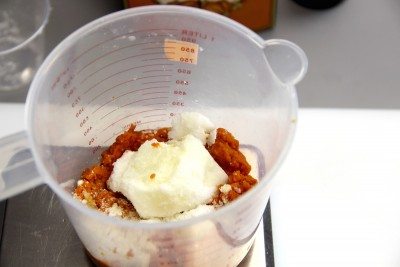









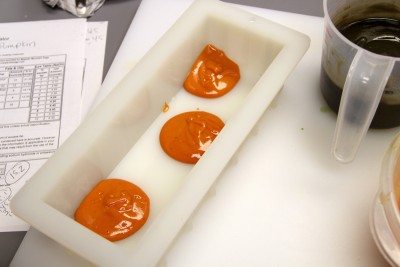

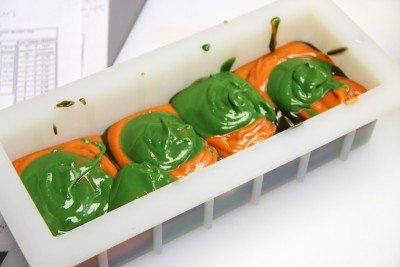


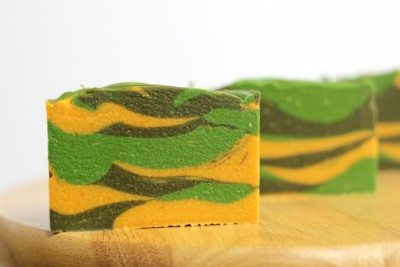

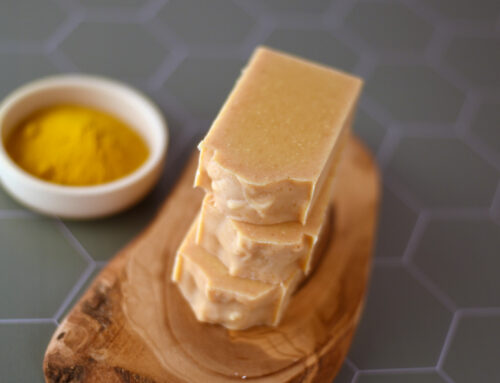



Hi.
This recipe looks like so much fun. Crazy question I only have 2oz of Shea on hand. What other oil can I add to make up for the other 2ounces?
Hi ma’am
Can u help me for new startup soap industry
Can this be done using Room Temp Soaping (Measuring hard and soft oils separately. Adding Fragrance, additives, to soft oils and lye/water to hard oils then blending)?
Or HP?
(Since I’m falling in love with both)
HELP?!?!?
I believe it could, but I haven’t done that yet with this recipe.
Hi, I was just wondering about the pumpkin. Recently someone said that adding fresh things like fruit and botanicals can be risky regarding possible spoilage/DOS/moulding What do you think? I did have some issues with a soap containing green tea powder so Im a bit nervous about adding botanicals at the moment. Sorry my question is a bit off track from swirls.
I’ve never had an issue adding pumpkin. Along as it is a puree and there are no big chunks…you should be good.
I use a wooden mold that I line with butcher paper. Do you not have to line this type of mold that you used here? Does the soap just slide out? 🙂
This is a silicone mold and doesn’t require lining. I LOVE not having to line.
Hi Amanda,
I have a question about the pumpkin puree. Why not mix the puree at the last step that is just light trace ? I was thinking if it could retain a bit more nutrients of pumpkin when adding after light trace.
Hi Ada – you could add to trace instead; it is really a matter of preference. Most of the reaction takes 24 hours to occur, so I don’t think it will save the pumpkin by adding it to trace. It will have the same contact with the lye.